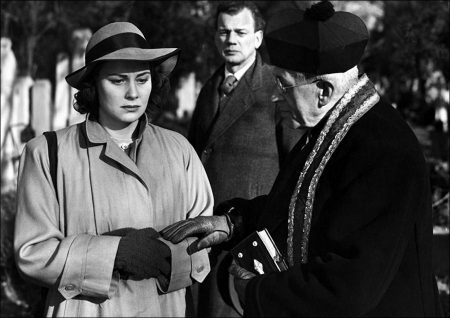The Third Man (1949) is a visually-stylish thriller – a paranoid story of social, economic, and moral corruption in a depressed, rotting and crumbling, 20th century Vienna following World War II. The striking film-noirish, shadowy thriller was filmed expressionistically within the decadent, shattered and poisoned city that has been sector-divided along geo-political lines.
The black and white, pessimistic film is one of the greatest British thrillers of the post-war era, in the best Alfred Hitchcock tradition, and beautifully produced and directed by Britisher Carol Reed. It was voted the #1 British Film of the 20th Century by the esteemed British Film Institute (BFI). It was co-produced by Hungarian-born Alexander Korda and American movie mogul David O. Selznick. Because Korda gave American distribution rights to Selznick (who cut eleven minutes from the original British version), the credits of the US version include Selznick references.
This was Reed’s second collaboration with British screenwriter-author Graham Greene (after The Fallen Idol (1948)). It was based on Greene’s novella of the same name, written solely to be a source text for the film screenplay and never intended to be read or published. It was a clever and original mystery tale simply evoked by one sentence written by Greene: “I saw a man walking down the Strand, whose funeral I had only recently attended.”
It told of a love triangle with nightmarish suspense, treachery, betrayal, guilt and disillusionment. Its two most famous sequences include the Ferris-wheel showdown high atop a deserted fairground with the famous cuckoo clock speech (written by Orson Welles), and the climactic chase through the underground network of sewers beneath the cobblestone streets.
The Third Man is a 1949 British film noir directed by Carol Reed and written by Graham Greene. It stars Joseph Cotten, Valli, Orson Welles, and Trevor Howard. The film takes place in post-World War II Vienna. It centres on Holly Martins, an American who is given a job in Vienna by his friend Harry Lime, but when Holly arrives in Vienna he gets the news that Lime is dead. Martins then meets with Lime’s acquaintances in an attempt to investigate what he considers a suspicious death.
The atmospheric use of black-and-white expressionist cinematography by Robert Krasker, with harsh lighting and distorted “Dutch angle” camera technique, is a major feature of The Third Man. Combined with the iconic theme music, seedy locations and acclaimed performances from the cast, the style evokes the atmosphere of an exhausted, cynical, post-war Vienna at the start of the Cold War.
The Third Man (1950)
Directed by: Carol Reed
Starring: Orson Welles, Joseph Cotten, Alida Valli, Trevor Howard, Bernard Lee, Paul Hörbiger, Ernst Deutsch, Siegfried Breuer, Erich Ponto, Wilfrid Hyde-White, Hedwig Bleibtreu, Nelly Arno
Screenplay by: Graham Greene
Cinematography by: Robert Krasker
Film Editing by: Oswald Hafenrichter
Set Decoration by: Dario Simoni
Music by: Anton Karas
Distributed by: Selznick Releasing Organization
Release Date: February 2, 1950
Views: 372

